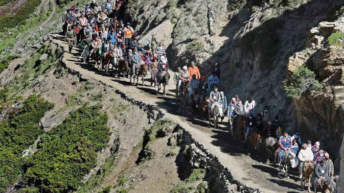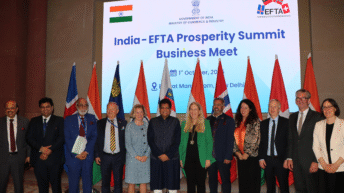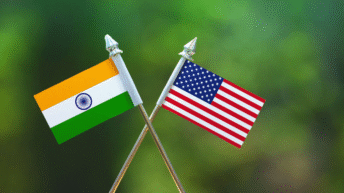
India’s north-east is home to Astro-asiatic tribes and most recent anthropological research, including linguistics study, has proven their connections with the Austronesians, the indigenous population of Taiwan, maritime Southeast Asia, parts of mainland Southeast Asia, Micronesia, coastal New Guinea, Island Melanesia, Polynesia, and Madagascar.
As the Indo-Pacific region becomes the fulcrum of intense geopolitical and geoeconomic contests, this Austroasiatic-Austronesian connection has all the potential to promote cultural diplomacy between India and Taiwan, and between other regional nationalities, according to experts.
“Aboriginal culture is symbolic to (sic) Taiwan because the aborigines are from the Austronesian ethnic group, which means they have no direct relationship with Chinese Han culture,” said Shen Ming-Shih, Director of the division of National Security Research and acting deputy CEO at Taiwan’s Institute for National Defense and Security Research.
The Austronesians, who today belong to 16 tribes in Taiwan, seemingly originated in Taiwan and began migrating southward around 5000 years ago across the sea, to the Philippines and, on to other regions. Austroasiatic languages belong to a group spread over Vietnam, Cambodia, Southern China, Thailand, Laos, Myanmar including parts of India’s northeast.
“Although Taiwan’s connection with China began around the Ming Dynasty, the aborigines had already been in Taiwan. This history also allows Taiwan to connect with Southeast Asian and Pacific countries and strengthen cultural exchanges,” said Shen.
The cultural exchanges that Taiwan wants to strengthen can open a new diplomatic avenue with India because India’s north-east, the home to diverse tribes, including austroasiatic ones belonging to the Munda and Mon-Khymer branches, not only features a large languistic, cultural and ethnographic cluster but also a massive labour force of interest to Taiwan.
The region has great tourism potential and offers a growing market and economy whose exports of tea and ethnic products already amount to 400 million Dollars equivalent.
Anthropological Connections
There has long been a debate about the cultural connection between the Austronesian and the Austroasiatic populations and in the past two decades, studies have revealed more evidence of this link . The two groups have different origins but they have much in common.
Waruno Mahdi, a 78-year-old celebrated linguist from the Fritz Haber Institute of the Max Planck Society, Berlin, Germany wrote a research paper in 2024 that empirically proved the linguistic connection between the Austronesian and the Austroasiatic tribes, including those of the Munda and Mon-Khymer branch that dwell in India’s north-east.
Mahdi’s paper titled “Austroasiatic loanwords in Austronesian Languages” is based on his decades-long research on the lexical borrowing from Austroasiatic into Austronesian languages and he proves the historical contacts and reciprocal linguistic influences between the two branches. Other researchers have found similar connections between specific tribes belonging to the two main branches of the ethno-linguistic family. In addition several genetic studies also prove the historical connection.
Sentila T. Yanger, a culture conservationist, craft curator, and textile expert from Nagaland, received India’s fourth highest civilian award, the Padma Shree in 2008 and was listed as a Women Achiever of India by the Ministry of Women and Child Welfare in 2021. Yanger believes that the potential of the cultural and historic connection between Austroasiatic and Austronesian tribes is still untapped and that India and Taiwan can develop it together.
“The ethnicity among (sic) the Formosa tribes aligns with (that of) the Northeast communities, particularly among the Khasi and Jaintias of Meghalaya who share and belong to the Austroasiatic ethnic group. They are akin to certain Taiwanese ethnic groups, and they speak the Mon-Khmer branch of the Austroasiatic linguistic family,” said Yanger.
Meghalaya is a state in north-east India, bordering Bangladesh; half of the population belongs to three tribes: Khasis, Jaintias, and Garos. Khasis and Jaintias belong to the Mon-khymer group of the Austroasian branch wheread Garos belong to the Tibeto-Burmese broup.
Yanger suggests that for those studying the cultural connection between the tribes of India’s north-east and Taiwan’s aborigines, the focus should be particularly on the Khasis because of their unique language construct.
“However when talking about other aspects of cultural affinities, then the Garos of Meghalaya, who belong to Tibeto Burman family, are similar in attire and ornaments, also with Arunachalee tribesman like Wancho, Nocte, Adi, Khamti, Singphos, mostly in their attires, and to some extent with the Konyaks of Nagaland,” Yanger notes.
The Konyaks are the largest ethnic group in Nagaland, another north-east Indian state bordering Myanmar. They are identified by their distinct facial tattoos and history of head-hunting, just like the Atayal tribes of central and northern Taiwan. Other aborigines of Taiwan like the Paiwan, and Tsou, also hunted heads.
In 2013, Andrea Acri and Alexandra Landmann organised a collaborative project that culminated in a conference about “Cultural Transfer in Early Monsoon Asia: Austronesian-Indic Encounters” at Singapore’s Yusof Ishak Institute. Along with Roger Blench, Acri and Landmann wrote a volume titled “Re-connecting Histories across the Indo-Pacific” which was the result of 14 scholars from multi-disciplinary fields coming together at Yusof Ishak to investigate the cross-cultural connections in the Indo-Pacific region.
“Indeed, many ‘local’ small-scale societies and cosmopolitan cultures in the region stretching from Eastern India and Southeast Asia to China and Japan were already plural from the earliest times, yet retain some remarkable common features, such as wet-rice monoculture and houses on stilts (Abalahin 2011, p. 661),” wrote the three authors in the volume.
They also found common religious structures such as their “dual organisation and a focus on an ancestor cult, often vaguely defined as ‘shamanic’ or ‘animist’ (Reuter 2014). Remarkably similar head-hunting and burial practices characterise the religion of Nāga tribes of Eastern India, as well as the former and present religions of some Tibeto-Burman and Austroasiatic-speaking ethnic groups settled in Myanmar, and might have been once widespread in maritime Southeast Asia, Taiwan, and the whole of Oceania.”
Cuisine, Tea, Bamboo, and Labour
Dr. Poonam Sharma, a post-doctoral researcher at the International Center for Cultural Studies (ICCS) at Taiwan’s National Yang-Ming Chiao Tung University in Hsinchu is originally from a small town called Diphu in central Assam. Sharma finds a distinct similarity between the local vegetable market of Assam and the local produce she finds in the morning markets of Hsinchu that are, incidentally, not found in New Delhi’s markets because north India offers a different food culture and produce basket.
Hsinchu’s vegetable market not only reminds her of her mother’s kitchen in Assam but makes it easier for her to feel at home in distant Taiwan because she even finds “chayote, roselle leaves, sponge gourd, jackfruit seeds, and sesame seeds” in abundance in Taiwan. This helps her feed her family, including her school-going daughter, with her mother’s time-tested traditional recipes.
Chayote, called “Iskos” in Assamese, is a common vegetable in Assam, used for cooking a rich cuisine consisting of curries, stir-fries, and even a kimchi-like dish called “Khar”. In Chinese, Chayote is called ”fóshǒu guā”. Northeastern India, one of the largest producers of bamboo in the world, also shares with Taiwan and other Southeast Asian countries a rich bamboo-shoot based cuisine. Yanger and Prof. Shen too vouch for the many similarities between the fare of Taiwan and the cuisines of South East-Asian nations, including a variety of meat dishes.
Similarities in dietary habits has been evoked by those who advocate for promoting labour migration from India’s Northeast to Taiwan. India and Taiwan established a Memorandum of Understanding on Feb. 16 last year to promote labour cooperation to help Taiwan meet its labour shortage crisis in the manufacturing industry. Though there is no official preference for any region, some voices support a partial or major intake from Northeastern India. Prof. Shen believes that similarities in dietary habits can be a major attraction, and he regards it as more important than the aboriginal connection.
“I think the diverse culture of Taiwanese cuisine is more likely to attract these immigrant workers, because the proportion of Taiwanese aborigines is not high, and they may not be able to have extensive contact with Taiwanese aborigines,” he remarked, adding that if these agricultural labourers go to Taiwan’s mountainous areas, where some Taiwanese indigenous people live, they will have the opportunity to interact with them and should be able to integrate quickly.
Trade and market
Sampa Kundu, a consultant at the ASEAN-India centre of the Research and Information System for Developing Countries (RIS), a New Delhi based thinktank, believes that the Austroasiatic and Austronesian tribes of Taiwan can help promote “ethical and sustainable tourism” and India and Taiwan should set up joint research and development for that purpose.
“In countries like India and Taiwan, rich in indigenous cultures and biodiversity, this model can drive inclusive development. By supporting community-run home stays, promoting eco-friendly infrastructure, and integrating traditional knowledge into tourism experiences, both nations can ensure that tourism benefits local people while protecting fragile ecosystems,” said Kundu.
There are eleven world heritage sites recognized by UNESCO–all of them are either national ecological parks or heritage villages or cultural sites. Taiwan has 17 potential world heritage sites–all of them are similarly either conserved ecological zones or heritage and cultural sites.
“India and Taiwan can develop joint initiatives such as cultural exchanges, shared heritage circuits, and capacity-building programmes for tour operators to help position themselves as global leaders in sustainable tourism,” said Kundu, adding that both countries can collaborate in research and development on ethical marketing, transparent revenue-sharing with the communities, and visitor education to promote respectful reciprocal engagement.
Gary Smoke is the Director/Vice-President of the Indigenous Bridges, a charitable foundation with a vision to preserve Indigenous culture and wisdom. His organisation runs the Indigenous Bridges Youth Ambassador Program (IBYAP) that brings youth from various indigenous groups together from around the world for empowerment and leadership building. On July 20, Gary’s team, along with the young ambassadors from the aboriginal communities of Taiwan, started their Pacific Northwest Tribal Canoe Journey, trying to emulate the historical migration of the Austronesians.
“There is also much to be learned from indigenous history. Indigenous people are the people closest to the land. They have developed techniques and processes that have provided for their existence without the convenience of modern technology,” said Gary. This traditional knowledge, according to him, could become a connecting vector between Taiwan and India’s Northeast.
Kundu said that both India and Taiwan should create a joint repository of elders, musicians, weavers, dancers, or local historians. These, according to her, are living archival record-keepers of their communities, passing down myths, folklore, rituals, and ecological wisdom.
“For example, the folktales of the Khasi people often reflect themes of harmony with the forest while Tai Khamti monks narrate Buddhist parables blended with tribal legends. These age-old ttraditions and art of storytelling can be clubbed with youth-led initiatives to help them revive,” she noted.
The traditional knowledge can gain more influence and recognition if further strengthened through efforts to create a joint global market and marketing strategy for ethnic products of the indigenous communities from the two sides.
India has established the Tribal Cooperative Marketing Development Federation of India Ltd. (TRIFED) under its Union Ministry of Tribal Affairs and has launched multiple promotion campaigns for products from the tribal communities of India’s Northeast according to a ‘local to global’ strategy for establishing markets within India and abroad.
Smoke wishes to create a single market for ethnic products from the indigenous tribes of India’s Northeast and Taiwan. “Certainly, I believe this is possible, and we have explored this in the past. However, current law requires government approval, and that always takes time,” said Smoke.
References
On the Relationship Between the Austroasiatic and Austronesian Languages in Southeast Asia by Trần Trí Dõi, Faculty of Linguistics and Vietnamese Studies, VNU University of Social Sciences and Humanities, 336 Nguyễn Trãi, Hanoi, Vietnam. file:///C:/Users/user/Downloads/1411-1-2760-1-10-20160719.pdf
Austro-Asiatic Tribes of Northeast India Provide Hitherto Missing Genetic Link between South and Southeast Asia by B. Mohan Reddy, B. T. Langstieh, Vikrant Kumar, T. Nagaraja, A. N. S. Reddy, Aruna Meka, A. G. Reddy, K. Thangaraj, Lalji Singh, Published: November 7, 2007 https://journals.plos.org/plosone/article?id=10.1371/journal.pone.0001141
Changmai P, Jaisamut K, Kampuansai J, Kutanan W, Altınışık NE, Flegontova O, Inta A, Yüncü E, Boonthai W, Pamjav H, Reich D, Flegontov P. Indian genetic heritage in Southeast Asian populations. PLoS Genet. 2022 Feb 17;18(2):e1010036. doi: 10.1371/journal.pgen.1010036. PMID: 35176016; PMCID: PMC8853555. https://pmc.ncbi.nlm.nih.gov/articles/PMC8853555/
Tagore D, Majumder PP, Chatterjee A and Basu A (2022) Multiple migrations from East Asia led to linguistic transformation in NorthEast India and mainland Southeast Asia. Front. Genet. 13:1023870. doi: 10.3389/fgene.2022.1023870
https://www.frontiersin.org/journals/genetics/articles/10.3389/fgene.2022.1023870/full






Add comment